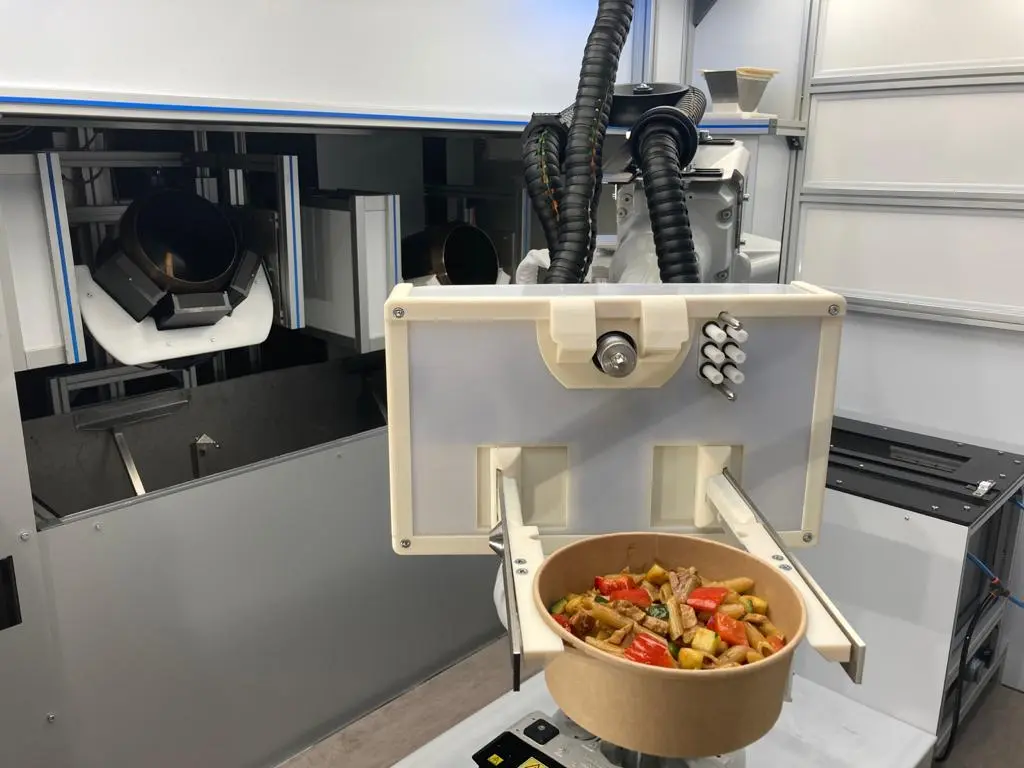
Healthcare Foodservice is Rising to the Challenge
Faced with budget pressures and staff shortages, healthcare foodservice is undergoing a quiet but necessary revolution. Here’s how robotics, AI and automation are creating more efficient, sustainable and deeply personalized dining experiences.

Here’s the thing about healthcare foodservice: The systems are complex, but the industry itself is deeply human. Most people are in this field because they want to help others. There is a baseline level of humanity in the industry, and that’s why investing in technology, just for the sake of it, won’t guarantee better patient experiences.
However, due to rising operational pressures healthcare leaders must find a way for humans and technology to work together to deliver better care.
Challenges Facing Healthcare Foodservice Today
Competition for patients and residents is fierce, and high-impact dining can set a healthcare facility apart. However, healthcare foodservice operators today are facing three core challenges that may make it harder to get there: tight budgets, skilled staff shortages and maintaining high levels of patient care.
Rising costs are eating into budgets
Feeling the budget squeeze? You’re not alone. Across the US, foodservice operators in healthcare facilities are having to do more with less due to rising labor and food costs eating into their budgets. In 2024, total hospital expenses grew by 5.1%, well above the 2.9% inflation rate. In this environment, every dollar counts.
Staff shortages persist
Finding and retaining skilled staff has become a near-constant struggle for healthcare foodservice operators across the country. A 2024 healthcare foodservice survey found that every team approached was short-staffed, and most were missing between 6%-10% of their team. Current staff are stretched thin, with morale dwindling.

There is a silver lining, however, as staff shortages are spurring healthcare foodservice operators to innovate more quickly than ever before.
Maintaining a high level of care is a high priority
Mealtime can make or break someone’s stay in (or visit to) a healthcare or senior living facility. While nutritious food is a core part of patients’ care, it’s also about pleasure and social connection.
However, maintaining a positive diner experience in healthcare settings is getting more difficult with higher costs and less staff bandwidth. Instead of letting their high standards slip, healthcare foodservice operators are turning to technology.
Opportunities for Healthcare Foodservice Teams
It's these very pressures that are encouraging the industry to rewrite the healthcare foodservice playbook. Emerging technologies are offering a dual benefit: a better patient experience and a more positive work environment for staff.
Improving patient, resident, and visitor dining experiences
There is a big opportunity to rethink (and improve) how facilities deliver meals. The aim is to give patients more control, more choices and higher-quality food, all of which directly impacts their satisfaction. So, how can operators do this?
On-demand bedside ordering is in demand
When it comes down to it, patients want flexibility. Fixed schedule meals serve a purpose, but they’re not the best route to high levels of patient satisfaction. That’s why several healthcare foodservice providers are using software to reduce the number of touchpoints in patient dining, including allowing them to select their meals using tablets. By linking digital meal ordering platforms to patients’ records, on-demand bedside ordering makes meals feel more personalized and accessible.

How is this working in practice? Very well, in fact. In August 2025, UNC Health Southeastern became one of more than 200 sites using mobile meal ordering to improve patient satisfaction and reduce food waste. Patients can use an app to connect to the hospital’s nutrition system and view and order meals based on their dietary needs.
The beauty of the on-demand model is that it works in two directions: patients get a more personalized experience, while the kitchen gets real-time data on consumption and preferences.
AI opens the door for faster data-driven decisions
This is where the real promise of AI comes in. Instead of replacing human intuition, it’s informing it. AI acts as a partner that quietly listens to all the data the operation generates, connects the dots, and finds what’s hidden within. It helps teams move from guesswork to a genuine understanding of what their patients and residents truly want.
So, what does that feel like in practice? We asked Dan Henroid, an expert in helping healthcare facilities improve their food and sustainability programs. “Artificial intelligence is going to be huge,” he said. “I’m most excited about the opportunity to be able to mine the data and synthesize quickly. There are reams of information in all these systems in healthcare foodservice, but synthesizing it, making it actionable and doing it fast is what AI is going to be able to give us.”
Think about the impact AI could have on staff scheduling. Today, managers build schedules based on gut feeling. AI takes out the guesswork by analyzing historical data to see the bigger, more accurate picture. It can identify patterns in service demand to predict when more staff will be needed weeks or months in advance. This means managers can build more efficient schedules that put staff in the right place at the right time.

AI gives teams the one thing they need most: the clarity to turn vast amounts of data into genuinely thoughtful care that improves patient satisfaction.
Tackling food waste is a top priority
As we move past the challenges posed by COVID-19, sustainability sits near the top of healthcare foodservice operators’ agendas. A 2024 FoodService Director survey revealed that reducing food waste is a top priority for operators by a landslide.

Cutting food waste is a no-brainer. More efficient production is a win-win. Overproduction, the most expensive form of food waste, is an ongoing problem in retail dining, such as cafeterias, and in patient and resident dining environments. Forecasting based on better, more accurate service results (not just gut instinct or limited historical information) can prevent tens of thousands of pounds of food waste and unnecessary food spend each year – but more on production solutions later.

Make efficiency gains by investing in back-of-house automation
Healthcare foodservice operators today find themselves in a bit of a bind – they can’t hire their way out of the problem and can’t shortcut their way to higher patient satisfaction. The only real solution to this problem is to change how work in the kitchen gets done. This is where technology comes into play – not as a replacement for humans, but as a partner.
Automating low-skilled tasks with robotics
Robotics is helping fill gaps from labor shortages by automating low-skilled, repetitive tasks. More kitchens are tasking robots with food preparation and delivery, taking some of the burden off busy kitchen teams that are already stretched thin.
What does this look like in practice? The Ohio State University Wexner Medical Center uses autonomous mobile robots (AMRs) to move dishes, food, and supplies to patient kitchens, freeing up staff time to focus on providing excellent patient care.
Some challenges, however, require more radical solutions. For example, Aramark has invested in RoboEatz’s Autonomous Robotic Kitchen (ARK) technology in partnership with ABB Robotics and WellSpan Health. The move comes as Aramark seeks ways to provide overnight dining options to keep healthcare teams going during long nights, and this robotic solution will deliver meals to nurses, doctors, hospital staff and visitors.

When asked where he thinks the biggest opportunity in healthcare foodservice lies, Dan said, “Robotics is a huge one.” He explained how the robots could be used not just in the kitchen but elsewhere as well. Dan, who had run a robotic fleet during his time working at UCSF Health, explained the impact the tech had: “There were 33 robots at one of the main campuses, and 6 of them were dedicated to the kitchen… the robots in the kitchen were shared with the linen team at night because the kitchen was closed.”
The real gift of this technology is the energy it gives back to healthcare foodservice staff. While robots handle the low-skilled, repetitive work, staff have more in the tank for skilled and compassionate work, like connecting with the patients who rely on them.
Optimizing kitchen production to reduce waste and save money
As we touched on earlier, many kitchens are ripe for optimization. According to Topanga’s calculations (and data from the EPA), the average foodservice kitchen loses an estimated 15% of their food budget on waste** each year. Until now, understanding exactly what happened on the line and reducing food waste meant wrangling physical worksheets or enforcing limited, time-consuming digital tracking tools. This is especially important in retail dining since food is batched and not made to order. Chefs have to correctly predict each dish’s overall popularity or let overproduction take its toll on their bottom line.
There hasn’t been an easy way to understand what was prepared, left over and thrown away in the kitchen during meal service. StreamLine changes that.
Topanga’s foodservice technology is trusted by 500+ kitchens across the country. Our StreamLine system gives culinary teams eyes on what’s actually happening in the kitchen. Think of StreamLine as your kitchen decision engine, helping you gain better data across every stage of production for accurate menu planning, less waste and greater team enjoyment. This visibility helps chefs tailor future food orders and production plans to prevent waste and only make what’s needed.

Here’s how StreamLine works:
- A team member records the food: A team member places a tray of prepared, carryover, or food waste, on the StreamLine countertop smart scale. With one touchscreen tap, the scale records weight and snaps a timestamped visual.
- AI analyzes the menu item: By integrating directly with your menu management system, StreamLine's AI identifies the menu item (and pan used), revealing the actual cost of waste.
- Data flows to your menu management system: For improved planning and reporting, StreamLine data is automatically added back to the menu management system.
- Chefs adjust their approach: With StreamLine’s clear production guidance and line-level results, chefs can adjust their approach for the next menu cycle to minimize wasted resources.
StreamLine gives culinary teams the clarity they’ve been missing, allowing them to make decisions with confidence, rather than relying on best guesses.
Final Takeaway
The way forward for healthcare foodservice is a fusion of the industry's innately human element and the tech that augments, not replaces our humanity. The answer to the sector’s challenges lies in letting tech, like robots and AI, handle repetitive tasks and complex data, while humans continue to do what they do best: turning a meal into a moment of connection for patients.
Want to find out how to optimize your kitchen by reducing waste and saving money? Schedule a StreamLine demo today.
.svg)

